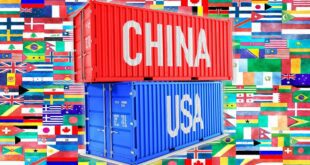Deflation is often considered a highly unfavorable phenomenon, however there are different types of deflation that have different implications. In other words, the effects of deflation depend to a large extent on the particular context…This article distinguishes between good deflation and bad deflation.
Good deflation
Good deflation is generally caused by a positive supply shock (i.e. an outward shift of the supply curve) that leads to the production of higher quantities sold at lower prices. In most cases, this type of deflation can be attributed to technological progress. New technologies allow companies to improve their production processes and reduce costs. As a result, the price level falls and (relatively speaking) money becomes more valuable.
An example of good deflation is the development of flat screen televisions. When they were introduced a few years ago, not many people could afford to buy one, because they were quite expensive ($3,000 – $4,000). However, due to technological progress and improved production processes, a flat screen television only costs about $600 – $1,000 these days…
Bad deflation
Bad deflation is caused by a negative demand shock (i.e. an inward shift of the demand curve) that leads to the consumption of lower quantities at lower prices. In other words, sellers have to reduce prices, because there is a lack of demand and they cannot sell their goods at the original price anymore. This is problematic in several ways:
- When prices fall, people tend to postpone purchase decisions because they expect prices to fall even more. That can lead to a vicious circle, since postponed purchases result in lower demand which in turn drives prices further down.
- The burden of debts increases, as the price level decreases. That is, if you were to borrow money today, the amount you would have to pay back in a year would be worth more. Admittedly, lenders profit from this situation. However, since they usually only spend a portion of the additional income, the economy will experience an additional decrease in overall spending (and thus the vicious circle mentioned above will be amplified).
- As a result of the lower revenue, companies will have to reduce costs. Because of sticky nominal wages (i.e. the fact that wages cannot be lowered without provoking resistance), they will have to let people go, thereby causing an increase in unemployment.
The example above illustrates why those forms of deflation are considered “bad”. At a first glance it may look like consumers are better off. However, there are significant negative effects on suppliers that will eventually affect consumers as well. This form of deflation is especially problematic, because of the self-amplifying nature of the process that can ultimately lead to a deflationary trap.
In a nutshell:
- Bad deflation causes a vicious circle, because
- people postpone purchase decisions,
- the burden of debt increases, and
- unemployment rises due to sticky nominal wages.
- Good deflation, on the other hand,
- is mainly based on technological progress and can actually be beneficial for both consumers and producers.
In conclusion, it can be said that deflation may be bad, but it does not necessarily have to be.
[The above article is presented by Lorimer Wilson, editor of www.munKNEE.com and the FREE Market Intelligence Report newsletter (sample here) and may have been edited ([ ]), abridged (…) and/or reformatted (some sub-titles and bold/italics emphases) for the sake of clarity and brevity to ensure a fast and easy read. The author’s views and conclusions are unaltered and no personal comments have been included to maintain the integrity of the original article. This paragraph must be included in any article re-posting to avoid copyright infringement.]
1. Deflationary Risks Rising In the U.S. – Here’s Why
Unlike a number of countries in Europe the U.S. is currently not dealing with general price declines but, that being said, the risks of such an occurrence have increased materially. This article outlines a number of such deflationary risks and how they might impact the U.S. economy. Read More »
2. Deflation: What You Need to Know (and Fear) & How to Prepare for Such an Eventuality
All in all, deflation should be one of the most serious words in a commodity investor’s vocabulary and is something to always keep an eye on. While its presence may seem removed from our economy, the possibility always remains and preparation will be key to survive a deflationary environment. Read More »
3. Inflation or Deflation: Are We Approaching the Tipping Point?
Might our Inflation-Deflation Watch be suggesting a breakout in asset price inflation is about to take place? Could it, in fact, be presaging the start of John William’s hyper inflationary depression in which prices rise exponentially even in light of massive unemployment and bankruptcies? This article analyzes the situation. Read More »
4. These 21 Countries Have Experienced Hyperinflation In the Last 25 Years
Hyperinflation is not an unusual phenomenon. 32 countries have experienced hyperinflation over the last 100 years of which no less than 21 have experienced it in the past 25 years and 3 in the past 10 years. The United States is one of the few countries to have experienced two currency collapses during its history (1812-1814 and 1861-1865). Could it happen again? Words: 1450 Read More »
5. Probability of Deflation Is 60%, Inflation Is 25% and Muddling Through Is 15% – Here’s Why
At the end of last year virtually every every single economist expected interest rates to rise this year as the Fed tapered their purchases and the economy improved but, in fact, interest rates on the 10 year U.S. Treasury have been going down year to date (from 3% to 2.5% after rising from about 1.6% to 3% last year). The masses, going along with this crowd, got fooled but we have been calling for a decline in interest rates for some time now due to world-wide deflation and it couldn’t be clearer to us that this is the most likely scenario for the United States. Let us explain. Read More »
6. We’re Headed for Crippling Deflation First & Then Rampant Inflation – Here’s Why
Are we headed for rampant inflation or crippling deflation? I believe that we will see both. The next major financial panic will cause a substantial deflationary wave first, and after that we will see unprecedented inflation as the central bankers and our politicians respond to the financial crisis. [Let me explain why I think that will unfold.] Words: 1025 Charts: 3 Read More »
7. 15 Questions & Answers Regarding Hyperinflation
It is difficult to say exactly when hyperinflation will hit a currency. However, I am convinced that the danger level is so high for most fiat money that it is worthwhile for everyone to increase their understanding of hyperinflation. This is the first part of a Hyperinflation FAQ for frequently asked questions or objections about hyperinflation. Words: 1600 Read More »
8. James Turk Interviews Robert Prechter: Which Will It Be – Hyperinflation or Massive Deflation?
James Turk believes hyperinflation is ahead. Bob Prechter believes massive deflation is coming. An interesting discussion between the two takes place in this audio. Ultimately, both lead to Depression. Only the route taken differs, but that is important. Read More »
9. Will the Current Whiff of Deflation Bring 2008 All Over Again?
You don’t need [actual] deflation—a reduction in the outstanding supply of money—to have markets react to a decrease in the rate of money supply growth…, anticipate the eventual deflation [and begin to price it into the market. Remember 2008?] Oil prices fell from $147 in July of 2008 to $33 per barrel by early 2009. The S&P 500 went into free-fall starting in September of 2008 and bottomed out in March of 2009—falling almost 50% in six months. This is what has already happened to the gold mining sector but, remember, central banks may be on a counterfeiting holiday right now but they have a history of taking very short vacations. Read More »
10. It is VERY Important to Know Where the Inflation-Delation Pendulum Is to Invest Correctly – Do You?
Global investors are now being violently whipsawed by the decisions of central banks, as they switch between inflationary and deflationary policies. The choice governments now face is to allow a deflationary depression to finally purge the worldwide economy of its imbalances, or try to levitate real estate, equity and bond prices by printing massive quantities of their currencies. Read More »
 munKNEE.com Your Key to Making Money
munKNEE.com Your Key to Making Money


